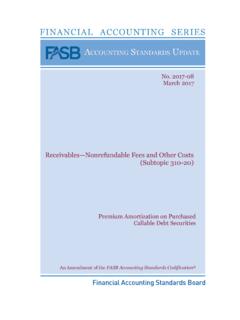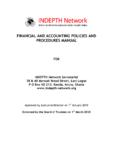Transcription of KATANGA MINING LIMITED CONSOLIDATED FINANCIAL …
1 KATANGA MINING LIMITED . CONSOLIDATED . FINANCIAL STATEMENTS. AS AT AND FOR THE YEARS ENDED. DECEMBER 31, 2017 AND 2016. KATANGA MINING LIMITED . CONSOLIDATED . FINANCIAL STATEMENTS AS AT AND. FOR THE YEARS ENDED. DECEMBER 31, 2017 AND 2016. TABLE OF CONTENTS PAGE. Management's Responsibility for FINANCIAL Reporting 2. Independent Auditor's Report 3. CONSOLIDATED Statements of FINANCIAL Position 4. CONSOLIDATED Statements of Loss and Comprehensive Loss 5. CONSOLIDATED Statements of Changes in (Capital Deficiency) Equity 6. CONSOLIDATED Statements of Cash Flows 7. Notes to the CONSOLIDATED FINANCIAL Statements 8-49. 1. KATANGA MINING LIMITED . Management's Responsibility for FINANCIAL Reporting The accompanying CONSOLIDATED FINANCIAL statements of KATANGA MINING LIMITED and its subsidiaries ( KATANGA or the Company ) were prepared by management in accordance with International FINANCIAL Reporting Standards ( IFRS ).
2 Management acknowledges responsibility for the preparation and presentation of the CONSOLIDATED FINANCIAL statements, including responsibility for significant accounting judgments and estimates and the choice of accounting principles and methods that are appropriate to the Company's circumstances. The significant accounting policies of the Company are summarized in note 3 of the CONSOLIDATED FINANCIAL statements. Management has established a system of internal control over the FINANCIAL reporting process, which is designed to provide reasonable assurance that relevant and reliable information is produced. Following the end of the second quarter of fiscal 2017, in the course of an investigation by the Ontario Securities Commission ( OSC ), information drawing into question the appropriateness of certain of the Company's accounting practices came to the attention of the independent directors of the Company (the "Independent Directors").
3 This information led the Board of Directors (the "Board") of the Company to request the Independent Directors of the Board, being Robert G. Wardell, Terry Robinson and Hugh Stoyell, to conduct a review of these practices. Under the direction of the Independent Directors, an internal review (the Review ) was undertaken. The Independent Directors engaged Canadian legal counsel, and a multinational accounting firm, to assist the Independent Directors to conduct the Review. The Review identified accounting practices that, among other things, incorrectly recorded the total tonnage of finished copper cathode production so that finished product inventories were overstated, incorrectly valued copper concentrate included in work in progress inventories, incorrectly valued ore in stockpile inventories and incorrectly valued property, plant and equipment during 2016, 2015 and prior periods, which practices were not appropriate and required adjustments to the FINANCIAL statements.
4 Following completion of the Review, on November 20, 2017, the Company filed restated audited CONSOLIDATED statements of FINANCIAL position as at December 31, 2016, December 31, 2015 and January 1, 2015, CONSOLIDATED statements of loss and comprehensive loss, CONSOLIDATED statements of cash flows CONSOLIDATED statements of changes in equity for the years ended December 31, 2016 and 2015, as well as unaudited CONSOLIDATED interim FINANCIAL statements as at, and for the three months ended March 31, 2017 (the Restated Financials ) and accompanying management's discussion and analysis ( MD&A ). The Board of Directors and management reassessed the effectiveness of the Company's internal controls over the FINANCIAL reporting and concluded that material weaknesses in the Company's internal controls over the FINANCIAL reporting existed as at December 31, 2016.
5 The material weaknesses are described more fully in the Company's MD&A for the three months and years ended December 31, 2017 and 2016. While management and the Board of Directors have identified and are in the process of implementing and monitoring remediation measures to strengthen internal controls, the material weaknesses identified by the Board and management cannot be considered fully remediated until the applicable remedial controls operate for a sufficient period of time. Accordingly material weaknesses in the Company's internal controls over FINANCIAL reporting continue to exist as at December 31, 2017. As the Company's processing of copper and cobalt was suspended until the resumption of the production of copper on December 11, 2017, the control environment that prevailed for the majority of fiscal 2017 was significantly less complicated than that which existed prior to the suspension of the Company's operations.
6 A number of the material weaknesses previously identified by the Board and management do not impact FINANCIAL reporting controls required in the absence of ordinary production and sales activities. In addition, based on the work performed during the Review by the Independent Directors, management, external auditors, outside legal counsel and outside accounting advisors, management and the Board of Directors concluded that the Company's previously filed restated CONSOLIDATED FINANCIAL statements are fairly stated in all material respects in accordance with IFRS. Against this backdrop, management and the Board of Directors have also concluded that the CONSOLIDATED FINANCIAL statements for the years ended December 31, 2017 and 2016 are fairly stated, in all material respects, in accordance with IFRS. The Board of Directors is responsible for reviewing and approving the CONSOLIDATED FINANCIAL statements, the accompanying Management's Discussion and Analysis and for ensuring that management fulfils its FINANCIAL reporting responsibilities.
7 An Audit Committee which is comprised of a majority of independent non-executive directors assists the Board of Directors in fulfilling this responsibility. The Audit Committee meets with management as well as with the independent auditor to review the internal controls over the FINANCIAL reporting process, the 2. CONSOLIDATED FINANCIAL statements and the auditor's report. The Audit Committee reports its findings to the Board of Directors for its consideration in approving the CONSOLIDATED FINANCIAL statements for issuance to the shareholders. The Company also has an internal audit function that evaluates and formally reports to management and the Audit Committee on the adequacy and effectiveness of internal controls specified in the internal audit plan. The independent auditor, who is appointed by the shareholders, examines and reports on the CONSOLIDATED FINANCIAL statements in accordance with Canadian generally accepted auditing standards.
8 Management recognizes its responsibility for conducting the Company's affairs in compliance with established FINANCIAL standards, and applicable laws and regulations, and for maintaining proper standards of conduct for its activities. Signed by Johnny Blizzard Grant Sboros . Johnny Blizzard Grant Sboros Chief Executive Officer Chief FINANCIAL Officer March 31, 2018 March 31, 2018. 3. Independent Auditor's Report To the Shareholders of KATANGA MINING LIMITED We have audited the accompanying CONSOLIDATED FINANCIAL statements of KATANGA MINING LIMITED , which comprise the CONSOLIDATED statements of FINANCIAL position as at December 31, 2017 and 2016, and the CONSOLIDATED statements of loss and comprehensive loss, CONSOLIDATED statements of changes in (capital deficiency) equity and CONSOLIDATED statements of cash flows for the years ended December 31, 2017 and 2016 and a summary of significant accounting policies and other explanatory information.
9 Management's Responsibility for the CONSOLIDATED FINANCIAL Statements Management is responsible for the preparation and fair presentation of these CONSOLIDATED FINANCIAL statements in accordance with International FINANCIAL Reporting Standards, and for such internal control as management determines is necessary to enable the preparation of CONSOLIDATED FINANCIAL statements that are free from material misstatement, whether due to fraud or error. Auditor's Responsibility Our responsibility is to express an opinion on these CONSOLIDATED FINANCIAL statements based on our audits. We conducted our audits in accordance with Canadian generally accepted auditing standards. Those standards require that we comply with ethical requirements and plan and perform the audit to obtain reasonable assurance about whether the CONSOLIDATED FINANCIAL statements are free from material misstatement.
10 An audit involves performing procedures to obtain audit evidence about the amounts and disclosures in the CONSOLIDATED FINANCIAL statements. The procedures selected depend on the auditor's judgment, including the assessment of the risks of material misstatement of the CONSOLIDATED FINANCIAL statements, whether due to fraud or error. In making those risk assessments, the auditor considers internal control relevant to the entity's preparation and fair presentation of the CONSOLIDATED FINANCIAL statements in order to design audit procedures that are appropriate in the circumstances, but not for the purpose of expressing an opinion on the effectiveness of the entity's internal control. An audit also includes evaluating the appropriateness of accounting policies used and the reasonableness of accounting estimates made by management, as well as evaluating the overall presentation of the CONSOLIDATED FINANCIAL statements.







